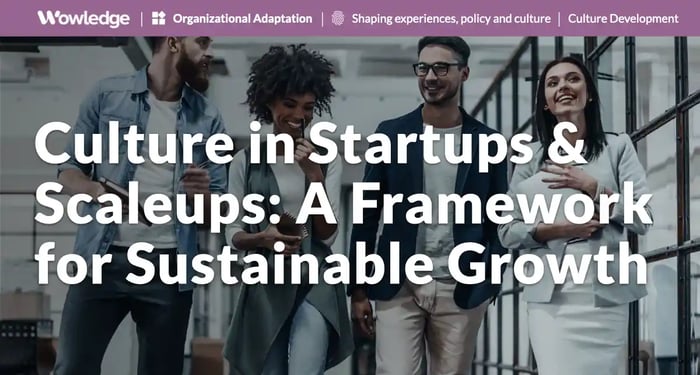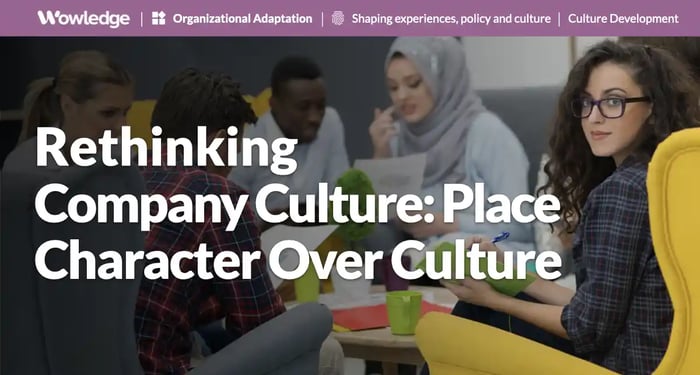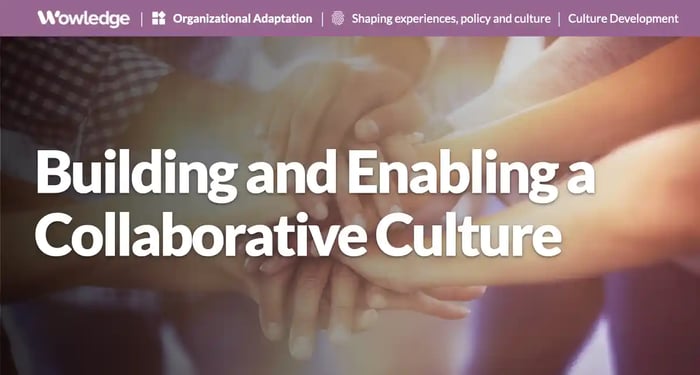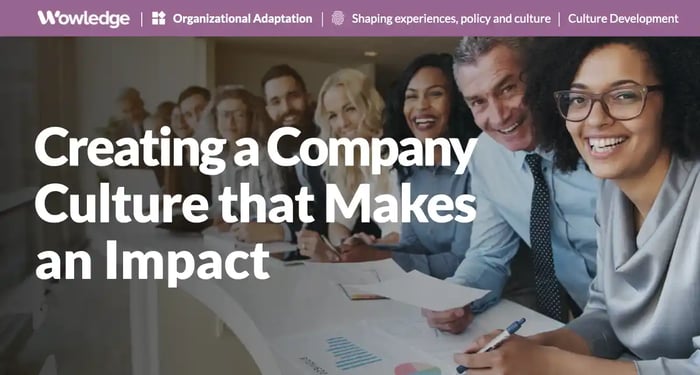Table of Contents
- Understanding the nature of organizational culture
- The substantial impact of culture on business and talent outcomes
- What makes culture in startups and scaleups unique
- Characteristics of an effective culture in small to medium-sized businesses
- Types of culture in startups and scaleups
- Key elements to establish a sustainable culture in startup and scaleup organizations
- Best practices for managing culture in startups and scaleups
- 1. Integrate mission and core values into operations
- 2. Proactively manage all leaders
- 3. Measure and track alignment
- 4. Install “culture carriers” into new operations
- 5. Reassess and update using change management
- 6. Decisively intervene with outliers
- 7. Install formal governance
- 8. Translate the culture to different operations
- Relevant Practices & Tools
- About Wowledge
Establishing and managing organizational culture is widely considered, yet often misunderstood and under-managed. It is a core element of a company’s purpose, success, brand, and work life. It lays the foundation for how an organization operates, identifies priorities, delivers value, and is structured and managed. As companies are founded and mature, managing their culture during startup and scaleup phases has a disproportionate impact on their likelihood of survival and success.
Understanding the nature of organizational culture
Culture is most commonly defined as a set of shared values, beliefs, and behavioral standards. It describes the elements of organizational life that are considered somewhat ethereal and thus difficult to describe and explain. However, these can start with generic statements that can, in fact, be explained in more concrete terms. For example, “culture” describes:
- How things get done, or what leaders and employees focus on when performing their work. This can include following structured vs. flexible task approaches, prescriptive vs. suggestive management and leadership guidance, planful vs. reactive actions and behaviors, and the extent to which the work is collaborative vs. autonomous.
- What is prioritized, or the extent to which financial performance, operational execution, customer outcomes, employee needs, and external stakeholders' requirements are balanced and addressed.
- How decisions are made, which relates to the locus and level of control or discretion that is exercised, including individual leader vs. distributed downward, the breadth of inputs and how they are collected, and to what extent failures or shortcomings are assigned blame vs. discussed as learning points.
- How people connect to the organization, in terms of shared values, mission orientation, relationships vs. goal focus, and how success is recognized (individual vs. team vs. organization-wide).
- How people work together covers the norms, expectations, and structures that define how and when work is performed at individual, team, or functional levels. It relates to the extent to which employee tasks are conducted primarily in a collaborative vs. individualized manner, how hierarchical and functional boundaries are maintained vs. crossed, meeting frequency, cadence, and membership, as well as how work outputs are integrated and handed off.
Culture comes through in how leaders act and guide their teams' performance, how (and what) information is shared, and how disagreements are managed. It directly impacts how productive, innovative, and collaborative employees are—within and across the teams to which they belong.
The substantial impact of culture on business and talent outcomes
Companies of all sizes and maturity levels have demonstrated the value of fostering a productive culture. For example, research from Great Place to Work consistently finds that great culture leads to substantially higher financial returns and employee retention, as well as superior levels of innovation and customer service. The 100 Best Companies generated three times (3X) the annual financial returns over a five-year period compared to the Russell 3000 Index.
Similarly, Aon research found that companies with a culture aligned to their purpose and business goals realize:
- 4.4 times higher revenue
- 4 times higher EBITDA
- 4% lower turnover
- 6% lower new hire attrition
- 13% higher net promoter scores (NPS) from their employees
Organizations with strong performance cultures achieve 2.5x higher revenue growth than the competition, and their employees generate 23% higher profitability and 18% higher productivity, driven by higher levels of employee engagement.
At the same time, consideration of the impact of poorly managed culture provides further evidence of the criticality of building and maintaining a strong culture in startups and scaleups. Toxic management and toxic work cultures drain subordinates and coworkers alike. With more founders-as-leaders focused on surviving startup and emerging into scaleup status, it should come as no surprise that some treat their people as expendable resources. For example, a surprisingly high occurrence (75%) of toxic work environments has been reported by employees across industries and company sizes.

What makes culture in startups and scaleups unique
Startups are differentiated by their relative youth, their focus on establishing their presence and a niche in the markets in which they are designed to compete, a focus on developing and testing core processes and marketing messages, and cultures that are most often founder-defined. The risk of business failures is ever-present, with the majority of these likely to fail within the first seven years.
Scaleups, on the other hand, have grown to the point where a sustainable business model has been proven, with annual staffing increasing by 20% and revenue growing to $1-$3 million and beyond. Their focus is on developing sustainability through the design of repeatable and reliable workflows, stable and consistent leadership and management, people, process, and quality product or service levels.
Company culture management shifts as the startup evolves into scaleup status. Consider that startups employ fewer employees, across a single (or fewer) locations, and are often focused on a few product and service offerings. As a result, the founding leaders can more directly observe and monitor their employees’ actions, decisions, and behaviors, enabling immediate improvement, corrective feedback, and coaching. In this way, the oversight and direct management of the culture is easier.
As the business matures into the scaleup phase, complexity increases as the employee population grows, locations expand, and more managers are appointed to directly guide and oversee the work of those employees. As a result, founders and top leaders lose their line of sight and continuous observation, ceding their ability to directly manage the culture. For these more established and stable organizations, these changes come as leaders are naturally required and able to focus increasingly on strategy, marketing, financial, growth, and other targeted business and operational directions and details.
Characteristics of an effective culture in small to medium-sized businesses
The goal of creating a sustainably effective culture in startups and scaleups is to foster an atmosphere that supports the organization’s mission, drives early wins and growth, and instills stability that reduces friction and absorbs inevitable missteps. For many early(er) stage companies, their ideal form defines the extent to which:
- Employees accept and act on the same set of ideals and values, focusing on the organization’s mission and business objectives.
- New ideas, thinking, and solutions are shared, considered, and accepted.
- People adapt, develop, and find opportunities to contribute and advance.
- Relationships are trusted, and new members are welcomed.
- A focus is on what people have in common versus their individual differences.
- Feedback from employees or stakeholders (customers, vendors, partners) is accepted and acted upon.
- High-value talent is attracted to, and seeks employment with the organization.
Each of these exists on a continuum, with each organization making its choices and acting on them through leadership-modeled and managerially guided behaviors and actions. They provide guidelines for decision-making that are nested in approved, widely-understood beliefs and standards, with priorities and processes clearly defined, the expected nature of relationships (with bosses, colleagues, and customers) clarified and accepted. Mechanisms are often put in place to communicate, challenge, review, and update the standards and expectations for each.
Types of culture in startups and scaleups
While academic experts have published culture “typology” models, in small to medium-sized businesses (SMBs), there are variants that are commonplace due to the often simpler nature of their operations, financing, and focus. These cultures can exist alone or in combination with each other, including:
- Founder-driven – internally focused. This type is based upon the nature or force of personality, visionary’s future, focus and drive, and preferences of the founder(s) who have envisioned a new model, operational focus, and culture that borrows from, or differs significantly from, those of their previous employers. Culture is largely defined and guided by leadership direction and focus.
- Mission-driven – externally focused. It is built around its primary purpose and core value proposition. It focuses on the quality and reliability of its service and products, customer passion & loyalty, community engagement and contributions, and environmental sustainability. It is noted for idealism and collective value generation, with employee needs often prioritized.
- Operationally-focused – internally focused. This culture type is often driven by the nature of its products or services, with a prioritization of cultural elements associated with control vs. collaboration, repeatability vs. innovation, cost vs. product quality, or efficiency vs. customer responsiveness. Culture is often placed on continua, including hierarchical vs. distributed decision-making and structured vs. autonomous work performance.
- Market-driven – externally focused. This is a high-performance culture type based on competitiveness, segment domination/market primacy, profitability, results, innovation, speed to market, agility, and adaptability. It is often characterized by highly selective hiring, stretch goals, well-defined minimum performance standards, and strict, comparative performance management practices.
Related cultural components can be included in job descriptions or employee value proposition (EVP) statements used to attract, screen, and select job candidates. These describe unique elements of the culture that support the utility employees are expected to bring to their work. These are offshoots of the founders' vision of what makes the organization great, what customer-facing organizations want to show and promote as part of their brand, and what they want to build in contrast to and to differentiate from previous employers and competitors.
- Data-driven
- Agile, adaptable, and flexible
- Continuous learning and growth
- Customer success, loyalty, and passion
- Structure and control
- Caring and well-being
- High performance
- Purpose-driven—community, environment, society
- Continuous improvement and process optimization
- Fun or family-like

Key elements to establish a sustainable culture in startup and scaleup organizations
Approaching the development, sustainment, and evolution of a culture that focuses on business objectives, operational priorities, and workforce stability requires a certain level of discipline from founders and top leaders. Regardless of whether the business is a restaurant with 50 employees, a manufacturer with 300, or a technology services provider with 1000 or more, the fundamental requirements are consistent. The extent to which any of these elements are implemented, partially or fully, in selected functions or levels of the organization will depend on their expected business value and the resources required. Having a formally stated description of the cultural aspirations will support the development and implementation of the following elements.
Hiring standards
Given the smaller workforce, the culture in startups and scaleups is more influenced by the traits, behaviors, work styles, and skills of fewer individuals. As a result, use the cultural elements that top leaders want to define their teams as selection criteria for all new hires, transfers, and promotions. What is crucial is consistency among employees in their acceptance, adoption, and demonstration of the organization’s core values, with management open to a diversity of perspectives and traits that bring more robust ideas and solutions. The use of competency models developed from the desired culture can be a powerful mechanism for alignment.
Performance management
Leverage the culture's expectations, behaviors, values, and capabilities as performance evaluation criteria in job standards, skills, and (task and development) goals. Provide coaching and development guidance that aligns with each employee's behaviors, decision-making, and action planning, guiding them to focus their efforts and behaviors on those areas.
Managerial style and expectations
Hold leaders and managers accountable for acting, providing direction, and making decisions that are consistent with the culture. Whether a competitive or people-focused culture, hiring and promoting managers, and overseeing their conduct and performance must be done in a way that aligns with the desired culture. Leaders and managers have a disproportionate impact on company culture, both in how they conduct themselves and in how they treat and manage employees.
Employee listening
Keeping an “ear to the floor” is essential to managing culture in startup and scaleup companies. Employee listening is the most effective way to understand how a culture operates, how it is experienced, and how it supports the organization’s mission and objectives. Employee surveys should be targeted towards assessing the same elements of culture to which the organization aspires. Management oversight and tracking is essential as well, through the use of 360-degree, or “upward feedback” surveys that provide feedback on how well managers and leaders are supporting cultural requirements.
Rewards and recognition
Pay increases, bonuses, employee awards, and related recognition activities should focus on supporting and promoting culturally aligned achievements, actions, behaviors, and decisions. Promotional and advancement standards should include the elements articulated in the company culture descriptions and be specifically called out when promotions, transfers, or other career advancements are announced.
Leadership championing and ownership
Top leaders wield substantial influence over the creation and maintenance of company culture, particularly in small- to mid-sized organizations. Role modeling the behaviors and messaging that support the defined and aspired-to culture is essential to culture management. As culture in startups and scaleups is driven from the top, their insistence on adherence to standards increases the likelihood that their subordinate managers will align, and communication and repetition are key. In fact, aligning stated values with actual behaviors is crucial to managers' adoption and to employees' trusting that the words they read and hear guide the culture.

Best practices for managing culture in startups and scaleups
Company culture, regardless of a company’s size and scale, will naturally evolve over time as complexities arise when top leaders come and go, the employee base expands, and operational growth brings more locations and facility types into play. The goal, however, is to ensure that the changes are consistent with the organization’s mission, business objectives, and desired workplace and workforce elements.
A number of leading practices can be relied upon to support the culture as the company faces inevitable changes and challenges that come with:
- Rapid or large-scale growth
- Mergers or acquisitions
- Major market shifts
- Geographic moves, additions
- Layoffs
- Top leadership changeovers
In any of these cases, certain approaches will support smoother transitions and help avoid the cultural shock that can disrupt business operations and continuity.
1. Integrate mission and core values into operations
Bring cultural elements into discussions and sessions on designing and improving business strategy, talent processes, policies, succession management, and development. Review those elements to ensure continued alignment with and relevance to the business purpose or mission, strategic objectives, and operational effectiveness. Similarly, periodically review the culture statement to ensure it aligns with and remains relevant to business objectives.
2. Proactively manage all leaders
Observe, measure, coach, and guide all management personnel in their behaviors related to the cultural setting and management. Understand that different individual leadership and management styles and priorities can shift towards or away from creating and sustaining the desired organizational culture. Do not hesitate to coach, correct, or dismiss any leader or supervisor who violates cultural norms.
3. Measure and track alignment
Listen and watch closely for signs of individual or organizational deviation from culture-supporting expectations. Consider decisions, policy preferences, operational outcomes, and collaboration patterns as they relate to cultural priorities such as finance, sales, customer service, innovation, product development, or service delivery. Track KPIs related to employee well-being, including burnout, absenteeism, turnover, or external complaints or legal actions that might indicate failed cultural aspirations. Benchmark against leading organizations and industry competitors for culture-specific indicators.
4. Install “culture carriers” into new operations
When opening new locations, establishing new facilities, or conducting mergers or acquiring businesses, install role models for the organizational culture into critical roles on a temporary (e.g., 6-12 months) or permanent basis. Rely upon ongoing performance evaluations and competency assessments to identify those who are both properly skilled and capable of serving as ambassadors and trustworthy leaders and spokespeople for continuing the core elements of the culture in the new environment.
5. Reassess and update using change management
Consider the evolution of a culture as the business grows and expands, with planned cultural reassessments using employee listening (surveys, focus groups), mass communications, engagement and training sessions, and changes to integrated processes and standards. Consider using pulse surveys and ongoing listening to assess more nuanced shifts across the organization, functions, locations, and business units.
6. Decisively intervene with outliers
Take a strong, assertive stand against toxic leaders, managers, and colleagues who disrupt the culture and create challenges for their bosses, peers, subordinates, and customers. Coach and correct low-fit employees whose behaviors, actions, and decisions are below standard relative to constructive and positive collaborations, relationships, communications, customer, and stakeholder focus. Be prepared to manage them out of the organization for the sake of the culture and its members.
7. Install formal governance
Intentionally engage top managers in the oversight and management of culture through periodic (e.g., quarterly) reviews and discussions related to how well the culture is being maintained. Review KPIs, employee listening, situational assessments, and other reporting for discussions, follow-ups, and goal adjustments related to cultural consistency.
8. Translate the culture to different operations
As culture in a startup or scaleup organization naturally evolves, evaluate how it and associated policies and practices most effectively translate across different parts of the organization. Consider how to adapt the defined or aspired-to culture to more risk-avoidant, process-focused manufacturing or finance functions; more collaborative, flexible, or autonomous roles in engineering or marketing; or how a greater “freedom within a framework” culture can be adopted in sales, customer support, or service design and delivery.
Relevant Practices & Tools
Core Change Management Practices to Engage Stakeholders and Drive Sustained Adoption. >
Change Management is a set of activities to help people understand why changes are being implemented, communicate how different people or groups will be impacted, and prepare them to be successful so that the company can minimize resistance to change, garner support for change, and accelerate value realization... more »
Creating an Employee Experience that Bonds High Performers to the Organization. >
The employee experience constitutes the entire journey an employee takes with the organization. This includes everything from pre-hire to post-exit interactions and everything in between... more »
Defining Diverse Types of Awards to Support the Organization’s Culture and Enhance Overall Employee Engagement. >
Recognition is an institutionalized way of saying “thank you” to employees for a job well done and for the extra effort they put into their work... more »
Assessing Health, Safety, and Wellness Culture to Reduce Injury and Illness Risks and Strengthen Overall Employee Well-being. >
Organizational practices can impact the team's health and wellness beyond team members' behaviors. The global standards for a healthy and safe workplace include identifying and addressing employee health hazards... more »
The Behavioral Shifts to Drive Culture Tool: Determine and Communicate Expectations of Behavior Change and Cultural Alignment. >
This tool aids in determining and communicating expectations of behavior change and cultural alignment to new digital norms and ways of operating within the organization... more »
About Wowledge
Wowledge is the implementation-first platform designed for lean HR teams and consultants who need to design and scale strategic HR programs efficiently—without starting from scratch.
Our members gain access to continuously updated best practices, step-by-step guidance, expert-built tools, and customizable templates—all structured to accelerate the development and implementation of key HR programs.
Recognizing that every organization operates at different levels of sophistication, Wowledge’s scalable system of best practices follows a stage-based approach—Core, Advanced, and Emerging—ensuring HR professionals can implement solutions tailored to their organization’s unique needs and goals.
Your Shortcut to Amplifying HR Impact!
Get started for FREE! Learn more.










